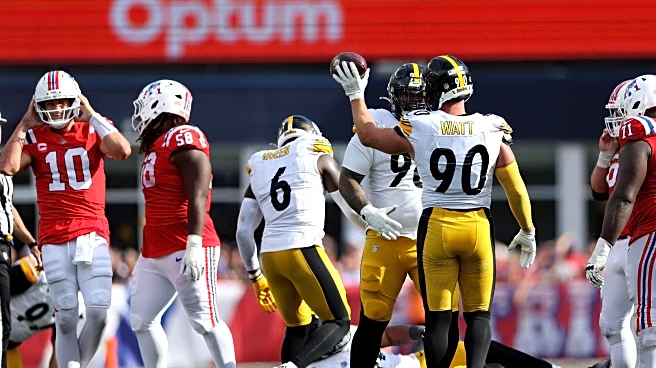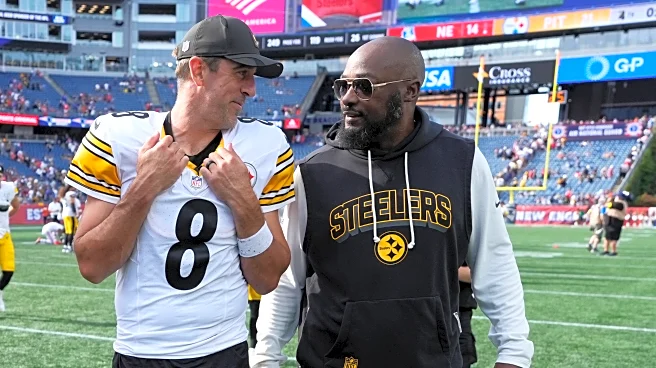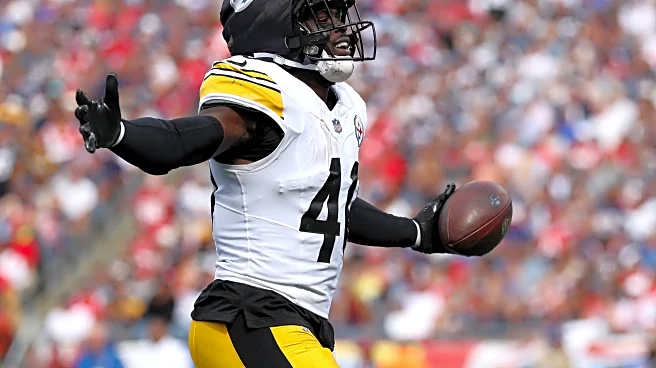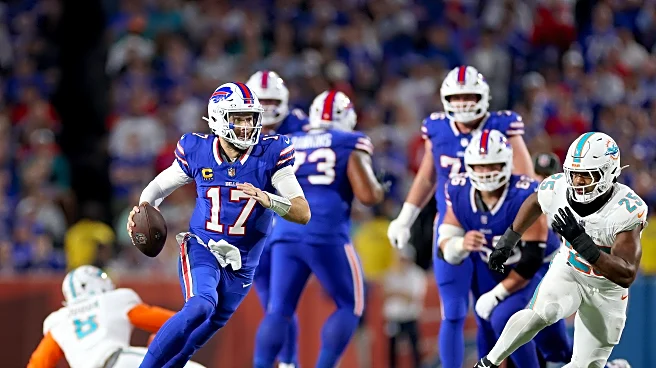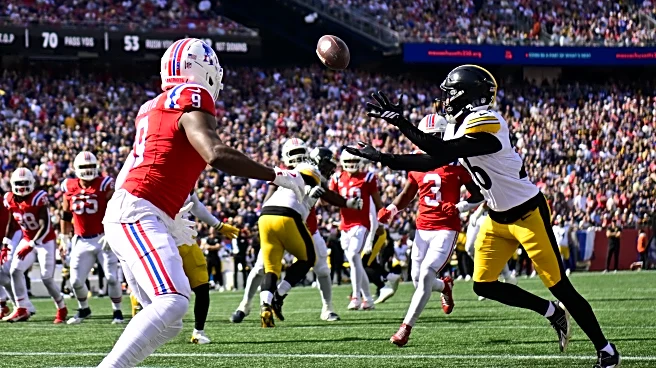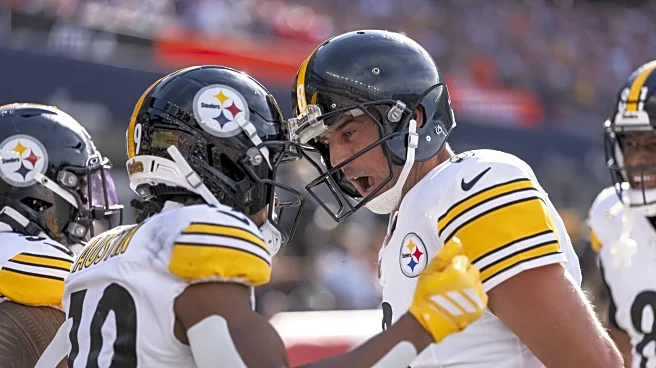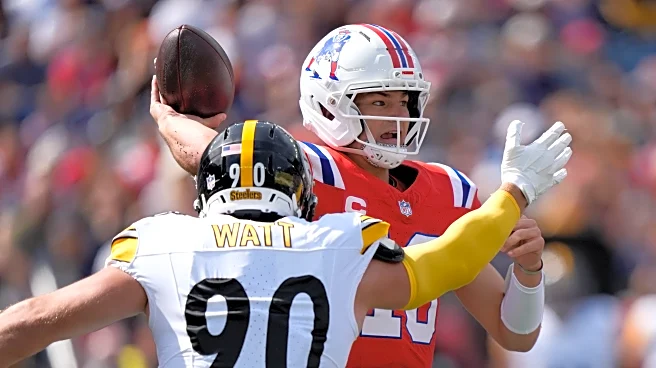The Steelers are 2-1, somehow tied for the first spot in the AFC North entering Week 4, and no one really knows what to expect. Last week in this column, we asked who the 2025 Steelers really are – and after
a turnover-heavy, unorthodox win over the New England Patriots, it feels like we’re still not much closer to discovering the answer.
As a result, we’ll be looking at a similar theme this week. But we’ll start off by focusing on some defenders who made their Steelers debuts against the Patriots:
How did Derrick Harmon look in his Steelers debut?

RP: The Steelers didn’t want to overwork the rookie in his first game back from injury, so he wound up playing 35 snaps. Still, that was good for a 47% snap share, the third highest among Steelers defensive linemen.
On the day, the Patriots attempted 37 passes versus 29 rushing attempts, so it makes sense that the majority of Harmon’s snaps (25) were pass rushes. The Steelers moved him all over the line, playing him mostly on the left (28), but with snaps at every defensive line position except nose.
To the relief of Steelers fans, he didn’t take too long to register his first sack, either.
At the six-minute mark in the first quarter, Harmon lined up as a 3-technique by lining up in the B-Gap. At the snap, he fakes a rush to the outside but then cuts back inside, clogging up the middle of the pocket.
While that is happening, T.J. Watt is ripping around the left edge, and Cam Heyward and Nick Herbig are executing a twist. To do this, Herbig lines out wide, fakes a rush to the edge with his first step and a headfake to the outside. Herbig then plants his outside foot, drops his hips, and turns to sprint left to the gap between Watt and Harmon, fighting through traffic to cut behind the rookie. Simultaneously, Heyward runs a delayed loop outside after the tackle bites and overpursues Herbig inside, creating an opening for Heyward to get in Drake Maye’s face.
Heyward arrives just as Watt does, with the outside linebacker positioned slightly behind the quarterback and to his right. Maye steps up and to his right to avoid Heyward and Watt, but that escape route quickly closes off to him as Herbig fills the gap. Herbig gets skinny in traffic and uses the left guard and Harmon as leverage to get himself free and spring into the rushing lane. Maye is forced to step forward again, this time right into Harmon’s arms for the sack.
It wasn’t an individually dominant play for Harmon, but he gets rewarded for playing his role by collecting the sack on a great team rep from the Steelers’ frontline.
Beyond that, Harmon looked like a rookie playing in his first game.
In the reel above, you see plenty of flashes of potential from Harmon, but also a lot of near misses, or almost made plays. Like in the second play (0:13), Harmon gets good, quick penetration, but Maye gets rid of the ball fast to the back. We Steelers fans have been spoiled by watching Heyward for as long as we have, but I’d like to see the rookie get his hands up in the air on that play and try to swat the ball. However, kudos to Harmon for sticking with the play through the end, as he is the defender who eventually catches up to the running back to make the tackle.
Harmon’s power is evident in this tape, but he’s still figuring out how to use it in the NFL. He got caught up in a couple of double teams that he was nearly able to fight through (1:30), and he moved the pile on other plays (such as in 0:52 in the video below).
And in the first play below, he nearly gets a second sack against a Patriots bootleg. If he doesn’t take a false step inside after seeing the tight end fake that he was pulling to block, he likely has Maye dead to rights. Instead, Maye slips just past Harmon’s fingertips.
On the day, NFL Next Gen stats credits Harmon with creating three pressures, including the sack. In the grand scheme of things, it was an impressive debut for the rookie. He looked like he belonged, and he was rarely caught off balance rushing the passer. For a defensive line that has been pushed around early, it was a refreshing change of pace.
I would caution anyone from getting carried away with visions of Harmon fixing all of the Steelers’ early issues on defense. That said, I’m much happier to now have him taking snaps, rather than standing on the sidelines in street clothes.
How did the Oregon rookie do against the run, Ryland?
RB: As Ryan mentioned, Harmon only had nine snaps of run defense in his NFL debut. It was an extremely limited sample size, but in that handful of snaps when the runner went in his direction, the rookie first-rounder showed some promise.
His first run defense rep was his worst of the afternoon, but nowhere near a disaster. Harmon slants outside initially and gets easily sealed off by the right tackle, resulting in a good-sized hole. Harmon ends up defending the same gap as T.J. Watt, which looked like a miscommunication but still ended up as a fumble in the Steelers’ favor.
The next notable run defense rep came with Harmon losing some ground on an initial combo block, but he managed to disengage the moment the tight end moved to block Payton Wilson. Due to Patrick Queen blitzing from the weak side and Keeanu Benton slanting away from the gap, there’s no one to help out Harmon, and the run goes for a big gain. Antonio Gibson gets by Harmon, but it would’ve been a tough play for the rookie to make.
The next rep is where Harmon really showed that he can make an impact. Once again, he’s combo blocked on the right side, but this time he doesn’t give up any ground, splitting the blockers and bursting through his gap. TreVeyon Henderson has to bounce his run outside, and the Steelers’ second-level defenders clean it up.
The final rep I’ll highlight isn’t anything mind-blowing, but Harmon shows the awareness and effort, working his way towards the run and getting involved in the stop.
Harmon’s run defense wasn’t flashy, but as the game went on, he looked stout and capable. As Ryan alluded to, there will be some rookie growing pains, but Harmon is already disrupting and looking like one of the team’s better D-linemen.
While still just a rookie, his strength looks like an upgrade for the Pittsburgh defensive line. There’s every reason to be excited about what he can do with more opportunities later in the season. Remember: Harmon didn’t even get a full week of practice before his first NFL game.
Were the Steelers’ improvements against the run sustainable?

RB: One area where the Steelers looked better on Sunday was in run defense. They actually gave up two more yards (119 to 117) in Week 3 versus the Patriots versus Week 2 against the Seahawks, but 45 of those Patriots rushing yards came from quarterback Drake Maye, largely on scrambles. That’s to say, while not perfect, it was a step in the right direction for Pittsburgh.
Now at 2-1, it’s still pretty tough to tell exactly who the Steelers are through just three weeks. But I’m certain one improvement against the Patriots wasn’t a fluke: safety Jabrill Peppers making his Steelers debut and immediately providing a boost for the Pittsburgh defense.
With Juan Thornhill’s role reducing in the Steelers’ defense and DeShon elliott out with injury, Peppers was able to play 43 snaps against the Patriots, with 21 coming against the run.
I’ll be using film to back up my statements, but for those who care: Peppers is currently the fourth-best safety in the NFL right now via PFF, with an impressive 90.4 overall grade – including a league-leading 95.5 grade against the run.
Peppers’ game has elements of DeShon Elliott and even former Steeler Elandon Roberts. He’s the perfect addition to a team that’s needed to up the physicality in run defense this season.
From his first snap as a Steeler, he displayed a willingness to come downhill and make plays (Watch No. 40 — look for the guardian cap).
That attitude was there the entire day, with the Steelers deploying Peppers a lot like Elliott, putting him close to the line of scrimmage to make plays.
And I, like many, have missed the ultra-aggressive playing style of former Steelers linebacker Elandon Roberts this season. As a safety, Peppers can’t fill that role, but he showed a similar love for collisions against the Patriots.
This is the sort of mentality you want on a good run defense:
Next Gen Stats credited Peppers with three stops (negative EPA for the offense) versus the Patriots. He also logged six total tackles and a fumble recovery. He was around the ball and making an impact.
With DeShon Elliott eyeing a return against the Vikings this week, it’ll be interesting how the Steelers use both his and Peppers’ similar skill sets. But ultimately, it’s better to have two excellent safeties against the run rather than just one. I have a feeling Peppers will turn out to be a bigger addition than expected following his midseason signing. It’s just one game, but he’s playing at a high level.
But we need to talk about the passing game…

RP: Since Ryland played the role of good cop and showed you some improvements made on defense, I guess that means I’ve got to play the bad cop. Through three weeks, it’s clear that Aaron Rodgers and the rest of the Steelers offense are still struggling to get in sync. We’ve previously talked about the Steelers’ struggles in the run game, but the passing attack hasn’t been much better.
The Steelers’ passing game can be a misleading one if you take certain stats out of context.
For example, Rodgers’ seven passing touchdowns are currently tied for second in the league. Never mind that the figure is propped from a four-touchdown game against the Jets in Week 1 and that the offense has struggled to sustain drives since.
Rodgers is also one of the least pressured quarterbacks, having only been pressured on 27 dropbacks, the sixth fewest in the NFL. Of course, that’s largely because the Steelers struggle to sustain pass blocks, so they’ve leaned heavily on the quick, short passing game. This is evidenced by Rodgers getting the ball out on average after 2.61 seconds, the third-quickest among qualified passers. And despite this, Rodgers has been sacked seven times through three games, the eighth-most in the NFL.
This plays into the type of concepts the Steelers run, but also lingers in the back of Rodgers’ mind on plays where he could find a bigger play.
Take, for example, this rep where the Steelers run a simple mesh concept, but Rodgers treats the ball like a hot potato.
Or how about this play below? This one has several nits I’d like to pick, both with Rodgers and Arthur Smith’s design. To set you up for this play, I’d like to emphasize to you that the following was a third down with 12 yards to go.
Let’s start with the design. The Steelers appear to be running something close to the “Smash” concept on the right side of the field. In that design, the quarterback has a hi-lo read, with the outside receiver running a hitch or a curl, or some form of comeback route to the short to intermediate, while the slot receiver runs a corner route at a deeper distance. This can be especially effective against man coverage or Cover 2 because it exploits the space in coverage between the outside corner and the safety. It’s a concept that Rodgers ran for years to great success in Green Bay.
I say this concept is “close” to Smash because there are a few issues with it, if that’s indeed what they were running.
On this play, the Patriots show man, but then rotate into Cover 3 post-snap. Metcalf’s route, from this alignment, would typically run a hitch, or curl, or some route that stops short to create stress on the corner and safety. Except Metcalf never stops. He barely disengaged from the corner’s press and released outside, and the ball is out, but Metcalf keeps drifting downfield as if he was going to keep going vertical if Rodgers had more time.
Meanwhile, Scottie Miller is the man in the slot, which is the player who would run the corner route in the Smash concept. On this play, had Miller started to break to the corner as soon as he reached the 50-yard line, then he and Rodgers might have had an opportunity for a big play. The bailing slot defender’s hips were fully turned towards the inside of the field, and would have had a hard time flipping to get the out-breaking route. With Metcalf behind his defender, he could have helped shield that defender from dropping into the corner route. However, Miller doesn’t slow down until he reaches roughly the opposing 35-yard line. Once he does, Miller finally starts to break outside with a rather rounded route, but at that point, Rodgers has already checked down to the running back. I’m not sure if this is a blunder by Miller or a questionable design quirk from Smith, but Rodgers doesn’t throw it to Miller.
I do think Rodgers checks this down too soon. Again, it’s 3rd-and-12. I get that his progression likely determined that if Miller and Metcalf weren’t open, to hit the running back, but Rodgers doesn’t have anyone in his face and has Freiermuth on a delayed release after he chipped the edge rusher. Sure, maybe Freiermuth doesn’t make the marker, but Warren gets the ball behind the line of scrimmage and is eventually tackled at the depth Freiermuth would have been at as soon as he caught the ball, before any YAC opportunity.
Lastly, I don’t love the Calvin Austin utilization on this one. He runs a deep out-breaking route that doesn’t really serve to create space for anyone else. It would have been more effective, in my opinion, to have him run a deep in-breaking route. This would have served as a half-field Levels concept that puts stress on the linebacker to decide on whether he takes the tight end underneath or bails deeper to take the receiver running behind him.
That’s perhaps an overanalysis of a play where there was either a personnel error or a poor play design, but it highlights what I’m really trying to get at: the Steelers’ passing game struggles don’t have just one person solely at fault, or one easy explanation that will quickly fix their issues. It’s a combination of shakey pass protection, a gun-shy veteran who no longer has the same will to take hits as he did in his youth, imprecise execution from the skill positions, and potentially some questionable play designs.
Here’s another play that possibly paints that picture in an even simpler way.
These are just a handful of plays, but they illustrate some of the issues we’ve been highlighting since last season: primarily a lack of detail on routes from some pass catchers, as well as some concepts where the routes don’t always seem to build off of and benefit each other. And trust me, I have more clips in the chamber I could have used to hammer this home even further, but this article’s word count wasn’t already ballooning near 3,000, and we should probably let you readers come up for air.
On the season, Rodgers (-0.06) ranks 19th in EPA per dropback. His deep throw attempt rate (7.0%) is the ninth lowest in the league, and his 5.8 yards Average Depth of Target is dead last among NFL starters, nearly a full yard behind the likes of Kyler Murray (6.5), Joe Flacco (6.6) and Tua Tagovailoa (6.9). Rodgers is throwing behind the line of scrimmage on 27.9% of his throws, and 65.1% of his attempts are going nine yards or less downfield, with Rodgers totalling just 172 yards on throws 10 yards or longer thus far.
This limits the number of explosive plays the Steelers can manufacture. And it’s the type of problem that will only get tougher as the season wears on, and defenses start creeping in closer to the box with little fear of the Steelers’ ability to stretch the field vertically. That, of course, will also make running the ball harder with more defenders near the line of scrimmage.
The Steelers’ struggles are certainly not all on Rodgers. In many ways, it still wouldn’t be inaccurate to say he’s giving us the most talented quarterback play that’s been in Pittsburgh since Roethlisberger’s body started to fail him. But Rodgers is also less capable of covering up for the sins of his pass catchers and playcaller than ever before in his career.
Can the Steelers get back on track? Sure, anything is possible. The season is long. The Steelers’ pass catchers might finally sharpen their attention to detail on spacing. Arthur Smith might start putting them in better positions to succeed and give Rodgers some easier answers for when his first read isn’t there. The offensive line could finally start to gel.
But time will quickly run out for these Steelers if they don’t start righting the ship soon. This weekend, they’ll be facing a tough Vikings defense while out of their element and out of the country. And then it’s an early bye week before hosting a Browns’ defense that is nasty enough to pull out an upset against a Packers team that was starting to generate Super Bowl-level expectations. The schedule doesn’t get any easier with games against the Packers, Colts, Chargers, Bills, Lions, and two with the Ravens still on the horizon.
Join in on Steelers R&R by sharing your takes on this week’s topics. What are your thoughts on Derrick Harmon’s debut? Are the 2-1 Steelers headed in the right direction? Feel free to pitch future questions in the comment section or on Twitter/X: tag @_Ryland_B or @RyanParishMedia, or email us at steelersreadnreact@gmail.com.

